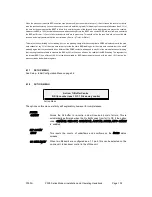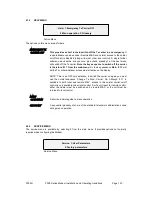
P300H
P300 Series Modem Installation and Operating Handbook
Page 145
8.3 PARTIAL INSERT AND MULTIDESTINATIONAL WORKING
Partial Insert is only available if the Extended D/I feature is available (standard on P300-TCM). In a
typical scenario, there may be a 2048kbps incoming carrier, containing say 8 timeslots (512kbps) for this
destination. When set to
ß´´
the full 2048kbps has to be received and passed to the terrestrial. When set
to
ﮬ·¿´
, only the 8 timeslots for this destination are selected and inserted onto the insert mux bearer
avoiding overwriting
all the data
on the bearer.
This technique can be applied to lower rate carriers also. Imagine four destinations, which require mesh
connectivity for simplicity say at 384kbps (6 x 64kbps, although asymmetric operation up to any rate is
possible). Each site has a modulator transmitting 1152kbps (3 x 384kbps), and three demodulators
receiving the 384kbps from the other sites. The satellite bandwidth requirement is for four 1152kbps
carriers, not twelve 384kbps carriers (ie the same aggregate rate, but possibly lower overall bandwidth
when carrier spacing is taken into consideration):
A single T1 or E1 bearer is looped through three modems, one operating as Tx/Rx, and two
others in Rx only. In this example we will assume it is a T1 PCM bearer.
The Tx data for all destinations arrives at the single Tx modem in each site on the T1 bearer in
18 timeslots. Note that the ability to re-order the Tx & Rx timeslots means the data can be in
any
timeslots and in any order.
Each of the four sites transmits a 1152kbps (3 x 384kbps carrier) and all four destination sites
receive the three carriers from the other destinations.
At each site all three modems are configured for Rx Partial Insert, and the data for all but this
site is discarded leaving a 384kbps to be inserted onto the looped T1 bearer by each Rx
modem. In this way the data from each site for this destination can be re-inserted into the
original timeslot from which the Tx data was dropped.
Without
Partial Insert
if each Rx modem inserts
all the received data
(18 timeslots) onto the T1 bearer,
then the second Rx modem could just about insert its 18 timeslots without stamping on the 6 timeslots
for this destination from the first Rx modem. However Rx modem 3, still has 18 timeslots to insert, but 12
of the timeslots on the T1 bearer now contain receive information from Rx modems 1 & 2, and so Rx
modem 3 cannot insert all its data without losing data from another destination. The traditional alternative
without
Partial Insert
is to use separate bearers for each Rx modem and a DACCS to sort our the data,
but it's lower cost and less equipment to configure and maintain if the DACCS is not required at all !
Partial Insert becomes
mandatory
for multidestinational working when the total receive data at any
one destination exceeds the capacity of the PCM bearers.
One final note: The P300 Series can provide multidestinational operation at aggregate carrier rates
below 1544 kbps using the IBS overhead, but
with four backward alarms.
So multidestinational
working down to 64kbps between nodes become practical (ie you don't have to use the 96kbps IDR
overhead on the links to get multidestinational backward alarm facilities).
















































